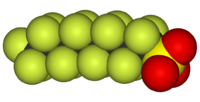
Photo from wikipedia
Contamination of soils with per- and polyfluoroalkyl substances (PFASs) is a global problem, in particular at fire-fighter training sites due to the usage of PFAS-containing aqueous fire-fighting foams (AFFFs). In… Click to show full abstract
Contamination of soils with per- and polyfluoroalkyl substances (PFASs) is a global problem, in particular at fire-fighter training sites due to the usage of PFAS-containing aqueous fire-fighting foams (AFFFs). In this study, an electrodialytic remediation method was applied for the first time to remove PFASs from contaminated soil. The electrodialytic remediation system was evaluated in a laboratory-scale experiment with current densities of 0.19 mA cm-2 and 0.38 mA cm-2 over 21 days, using PFAS-contaminated soil from a fire-fighter training site at Stockholm Arlanda Airport, Sweden. Of the 23 PFASs targeted, significant (p < 0.05) PFAS electromigration towards the anode was observed for C3-C7 perfluoroalkyl carboxylates (PFCAs) (PFBA, PFPeA, PFHxA, PFOA) and C4, C6, and C8 perfluoroalkane sulfonates (PFSAs) (PFBS, PFHxS, PFOS) since these PFASs were predominantly negatively charged. In contrast to the electromigration of the charged PFASs, N-methyl perfluorooctane sulfonamide (MeFOSA), perfluorooctane sulfonamidoacetic acid (FOSAA) and ethyl FOSAA (EtFOSAA) showed significant (p < 0.05) transport towards the cathode, which is probably attributed to electro-osmotic flow of these predominantly neutral PFASs. Mass balance calculations showed that for the shortest-chained PFASs (i.e., PFBA, PFPeA, PFHxA, PFBS, and PFHxS), up to 20% was extracted from the soil to the anolyte, which showed that electrodialysis is a possible in-situ remediation technique for PFAS-contaminated soil.
Journal Title: Chemosphere
Year Published: 2019
Link to full text (if available)
Share on Social Media: Sign Up to like & get
recommendations!